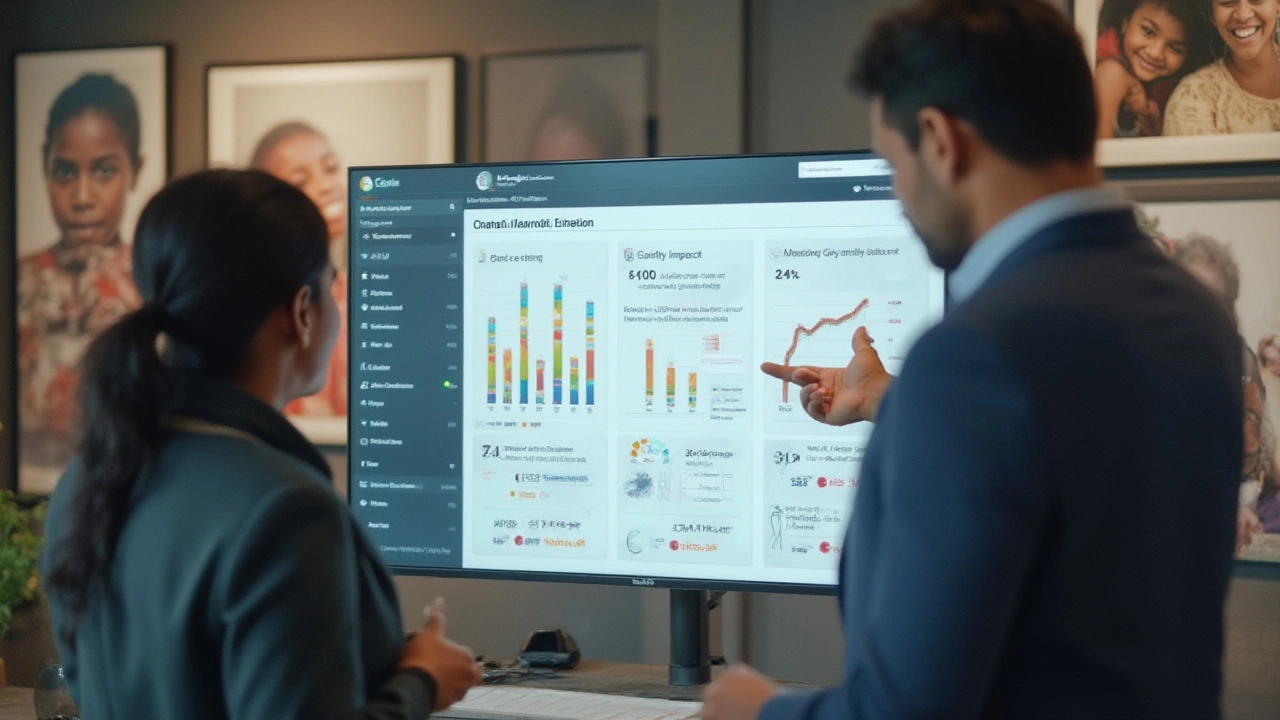Imagine dropping your hard-earned cash into a bottomless well, hoping at least a bucket’s worth splashes into the hands of someone who really needs it. That’s what it can feel like donating blindly to charity. People want their money to do something real—not just pay some fancy salaries or pile up in an endless bureaucracy. The problem is, not all charities work the same way, and not all are as effective or transparent as you’d hope. So, is there a clear leader? Which charity actually holds the crown for the highest rated charity in America, or even the world? Let’s get into the nitty gritty and put some big names under the microscope, checking the latest facts and numbers—so you know your next donation actually matters.
The Number Crunch: How Charity Ratings Actually Work
Getting the real scoop on charity performance means getting past big promises and heart-tugging stories, and looking straight at the facts. That’s what rating groups like Charity Navigator, GuideStar, and CharityWatch are all about. These groups dig through years of tax filings, website promises, and financial statements, then boil it all down to a star rating or letter grade. But what’s behind those stars and grades?
Charity Navigator, for example, looks at things like financial health, accountability, and transparency. They give a rating from zero to four stars. GuideStar takes a more data-heavy route, awarding seals—Bronze, Silver, Gold, and Platinum—based on how open and detailed a charity’s reporting is. CharityWatch goes the old-school route, grading nonprofits from A+ all the way down to F based on overhead and how much money actually makes it to real-world programs versus management and fundraising.
So, what counts for the highest rating? Basically, you want low overhead—no more than 25 cents out of each dollar to administration and fundraising—and clear, honest reporting. A top-ranked charity also shows real impact with measurable results. In 2025, people aren’t fooled so easily; they want proof their gift is making a dent in real problems, whether it’s cancer research, disaster relief, or feeding hungry kids. And the best groups deliver that proof right on their sites, posting up-to-date impact reports and independently audited financials.
You might be surprised, though—in a recent report by Charity Navigator, fewer than 20% of over 9,000 charities hit the perfect four-star mark. The majority land somewhere in the middle, which means there’s a short list of high performers.
Transparency is a hot topic. Some of the most respected groups go as far as putting their IRS Form 990s on their website for anyone to see. If a charity is hiding things or dancing around questions, maybe think twice. The rating sites have been getting stricter, too: GuideStar yanked dozens of organizations’ seals last year over fuzzy financials. Accountability may not tug at your heartstrings, but it does keep your donation from vanishing into thin air.
To help you compare, here’s a breakdown of typical criteria for a top score:
- Financial Health: Spending less than 15-25% on overhead.
- Transparency: Posting independent audits and full IRS filings online.
- Accountability: Reporting board changes and flagged issues quickly.
- Impact Measurement: Publicly sharing year-over-year program outcomes and statistics.
Curious what that looks like? Here’s how some leading names stack up, per recent 2025 data:
| Charity | Charity Navigator Rating | CharityWatch Grade | GuideStar Seal | Program Expenses (%) |
|---|---|---|---|---|
| Direct Relief | 4 Stars | A+ | Platinum | 99.4 |
| MAP International | 4 Stars | A+ | Platinum | 98.5 |
| Americares | 4 Stars | A | Platinum | 97.6 |
| World Central Kitchen | 4 Stars | A | Gold | 96.1 |
| DonorsChoose | 4 Stars | A | Platinum | 93.8 |
That ‘Program Expenses (%)’ column is the key; these groups spend nearly everything on real program work, not management or fundraising. Direct Relief, for instance, managed to put nearly 99 cents of every dollar to health programs worldwide in 2024—a crazy-high mark in the nonprofit world. If you like giving with your head as much as your heart, that’s the kind of number you want.

Who Is the Highest Rated Charity Today?
Okay, so who wears the crown right now? Direct Relief has been crushing the ratings for a few years straight. It checks every box: Charity Navigator gives it a perfect 100 out of 100, and on CharityWatch’s report card, it’s one of the rare A+ organizations. Their administration costs are among the leanest in the business, and they blast those numbers loud and proud right on their site. In 2024 alone, they delivered more than $2.9 billion in life-saving medical aid to over 80 countries, all while keeping overhead at just over 0.6%.
Why does this matter? Because Direct Relief’s focus is on immediate, practical help—getting medicines, equipment, and supplies directly where disaster or poverty hits hardest. No glitzy ad campaigns, no endless conferences—just warehouses packed with stuff people actually need, heading straight to the front lines.
What about others making the honor roll? MAP International deserves a tip of the hat here, too. In 2024, it distributed $880 million worth of medical aid with a shoestring staff, and 98.5% of its dollars went straight to programs. They’re tiny, but their impact is wild, leveraging huge medical partnerships to amplify every donation.
If your thing is food insecurity, World Central Kitchen is right up there—chef José Andrés’ group jumped into the four-star club thanks to lightning-fast disaster response (think Maui wildfires, Ukrainian war zones) and a lean, transparency-focused budget. Americares isn’t far behind, channeling more than 97% of resources directly to health projects around the globe.
DonorsChoose is also crushing it in education, letting real teachers fund classroom projects. They keep more than 90% of every gift going straight to student needs, and donors get proof—photos, teacher thank-yous, real impact updates. No black hole, no mystery.
Every year, some charities lose their high score if their numbers slip. The top spots are hard to hold. A four-star or A+ rating one year can drop fast if spending blips or a scandal breaks. Last summer, a few big names lost their stars when tax filings revealed ballooning executive pay and vague program descriptions.
Transparency watchdogs have started snooping for more than just balance sheets, too. Now, equity and diversity reporting, board independence, and honest results are essential to stay on top. If a charity fails to report a scandal or fudges numbers, it risks getting a rating slashed or even blacklisted.
Of course, some all-time popular charities—think American Red Cross or Salvation Army—don’t always grab those perfect scores. Large size can bring efficiency, but it often means more cash going toward fundraising campaigns, salaries, or red tape. That’s not illegal, but your dollar might go further at a smaller, hyper-efficient group if you’re aiming for maximum impact.
The top-tier winners are usually groups that stick to their lane—doing one thing, doing it right, and reporting it honestly. If you want to donate with confidence, start by checking their numbers and impact stories on the main rating platforms. If you spot a four-star Charity Navigator score and an A/A+ on CharityWatch, chances are good you’ve found a high performer.
Here’s a quick list of factors to watch for if you want confidence that your donation won’t get wasted:
- The charity publishes recent, audited financial statements.
- It earns consistently high marks from Charity Navigator, GuideStar, and CharityWatch over several years.
- Annual reports include measurable impact stories, not just feel-good anecdotes.
- There’s minimal executive turnover or hidden conflict of interest among leadership.
- They willingly answer tough questions and publish less-flattering program failures.
At the end of the day, a charity’s rating says as much about its honesty as its effectiveness. High scorers like Direct Relief, MAP International, and World Central Kitchen keep their books open and their mission clear, fitting the bill whether you’re giving big or small.

Tips for Picking and Supporting a Top Rated Charity
Here’s where stuff gets pretty real. Even among the highest rated charities, not all approaches are created equal. You want a group that’s not just efficient, but also a good fit for what matters to you—whether that’s disaster relief, homelessness, education, or climate action. So before you click ‘donate,’ ask yourself: what change do I want to see, and does this charity have the proof that it actually moves the needle?
Start with the basics. Go to Charity Navigator, GuideStar, and CharityWatch and search up the charity’s name. Look at more than just the score—read the breakdown. Does the group keep administrative and fundraising costs low (under 20%)? Are there red or yellow warning flags? A badge or a perfect score shouldn’t be enough on its own; dig in. See if they post their IRS Form 990s (that’s their tax return) and independent annual audits, along with exactly how much they spend per program. If you can’t find those, or if the numbers are out of date, that’s a sign to look elsewhere.
Don’t ignore smaller or local charities—sometimes the biggest bang for your buck comes from an organization right in your backyard. These groups may not always make the top of the national lists, but smart donors look for low overhead, clear transparency, and up-to-date reporting no matter the charity’s size. If you care about community impact, a quick search on local watchdog groups can help find hidden gems.
Want your gift to stretch even further? Look up charity efficiency on GiveWell or The Life You Can Save, which focus on cost-per-outcome (like how many malaria nets or classroom books delivered per dollar). Groups recommended by them often aren’t household names, but they deliver real-world results for each penny spent.
These days, watch out for scams or knock-offs. Fake charities pop up after disasters and around holidays. Always verify an organization’s tax status—‘501(c)(3)’ is the IRS-speak for the real deal—and double-check the web address before entering payment info. If a charity is hitting you with high-pressure asks, sob stories with no numbers, or can’t provide clear recent impact updates, walk away.
If you really want to make a dent with your donation, consider setting up a recurring monthly gift. A lot of charities—even the highest rated—say recurring donors make them vastly more stable, letting them plan better and spend less on constant fundraising. Many groups report that just $10-$20 a month helps them count on funds year-round, maximizing impact and minimizing admin.
Finally, don’t underestimate the power of sharing. When you find a transparent, effective charity, spread the word—share it with friends, family, or on social media. Small, regular donations add up. A real story about a group like Direct Relief delivering medicine after a hurricane or World Central Kitchen feeding entire war-ravaged towns is more persuasive than any rating badge.
If you want to go deep, some platforms let donors track exactly where the money goes. DonorsChoose lets you see classroom projects by region, and places like GiveWell update live outcomes and cost-per-life-saved. The “impact dashboard” is the new way of giving if you’re a data geek—or just want proof your gift did more than buy coffee mugs for a boardroom.
So, the next time you reach for your wallet, don’t settle for guesswork. Check the ratings, ask for proof, press for details—your donation deserves it. Charity in 2025 is about putting power in the hands of givers, not just grateful press releases. Demand the numbers, look for honesty, and give smart. Top-rated charities might change over time, but smart, thoughtful giving never goes out of style.



